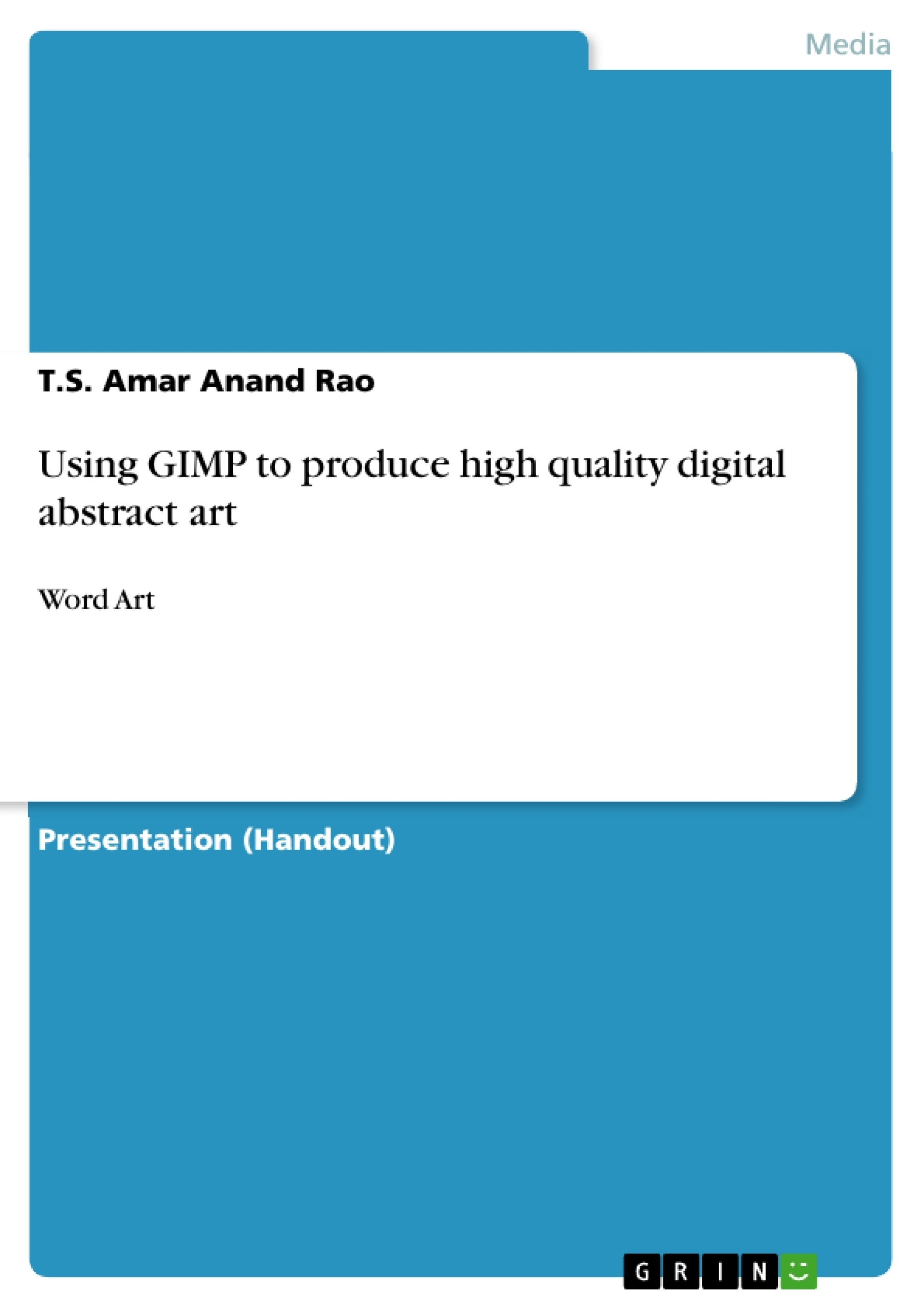I hereby present the results of using GIMP to produce high quality wallpaper images or digital abstract art. It is evident that it is not only need to be used as a photo editing software but can also be used very creatively. And these art can be sold as wall papers or wall Frames etc.
Table of Contents
- Introduction
- Materials and Methods
- Results
- Discussion
Objectives and Key Themes
The objective of this work is to demonstrate the capabilities of GIMP, an open-source software, in creating high-quality digital abstract art. The author explores the software's features and tools to produce various abstract images, showcasing its potential beyond photo editing.
- Utilizing GIMP for Digital Art Creation
- Exploration of GIMP's Tools and Features
- Creation of High-Quality Abstract Images
- Potential for Commercialization of Digital Art
- Comparison with other Software Packages
Chapter Summaries
Introduction: This introductory chapter sets the stage by highlighting the rising popularity of open-source operating systems, particularly Ubuntu, and their influence on software usage. It introduces GIMP as a readily available and powerful tool within this ecosystem. The chapter also defines abstract art, emphasizing its subjective interpretation and the potential for intricate detail in digital forms, particularly when created using GIMP, contrasting its capabilities with vector graphics software like Inkscape.
Materials and Methods: This section details the author's process for creating digital abstract art using GIMP. It describes the initial setup, including file creation and pixel size selection. The core of the methodology centers on the experimental and intuitive use of GIMP's diverse painting tools—spray, pencil, brush, smudge, burn, fill—and the application of various filters (light filters, enhancers, etc.) to generate a wide range of shapes, shades, and effects. The author emphasizes the random and exploratory nature of their creative process, highlighting the versatility of GIMP in enabling such experimentation. The chapter concludes with a discussion on the preferred export format (JPEG) for easy sharing and commercial purposes.
Results: This chapter presents the results of the author's experimentation. It lists several titles of the created digital abstract art pieces ("Web NeonMist," "SpirulinaSilk," etc.), showcasing the diversity of styles and imagery achieved. The author also points to an online portfolio (http://www.mistsofmind.wordpress.com) where the complete collection of these digital abstract artworks is showcased.
Discussion: This section reflects on the ease and efficiency of producing high-quality digital abstract art with GIMP, contrasting it favorably with Adobe Photoshop and Inkscape. It emphasizes the speed and creative freedom offered by the software, enabling the creation of stunning pieces within a relatively short timeframe. The discussion hints at the potential for commercial applications and exhibition of the produced artworks.
Keywords
GIMP, digital abstract art, open-source software, Ubuntu, digital painting, image editing, experimental art, surrealism, online art portfolio, commercial art, wallpaper design.
GIMP Digital Abstract Art: Frequently Asked Questions
What is the main topic of this document?
This document is a comprehensive preview of a work exploring the creation of high-quality digital abstract art using GIMP, an open-source software. It details the process, results, and potential applications of this approach.
What are the key themes explored in the document?
Key themes include utilizing GIMP for digital art creation, exploring GIMP's tools and features, creating high-quality abstract images, the potential for commercialization of digital art, and a comparison with other software packages.
What are the objectives of the work described?
The objective is to demonstrate GIMP's capabilities in producing high-quality digital abstract art, showcasing its potential beyond photo editing.
What is the structure of the work?
The work is structured into four chapters: Introduction, Materials and Methods, Results, and Discussion. Additionally, it includes a table of contents, objectives and key themes, chapter summaries, and keywords.
What does the Introduction chapter cover?
The introduction sets the context by discussing the rise of open-source software and introduces GIMP as a powerful tool. It defines abstract art and contrasts GIMP's capabilities with vector graphics software.
What does the Materials and Methods chapter describe?
This chapter details the author's process, including file creation, tool usage (spray, pencil, brush, smudge, burn, fill, filters), and the experimental nature of the creative process. The preferred export format (JPEG) is also discussed.
What are the results presented in the document?
The Results chapter lists titles of created digital abstract art pieces and directs readers to an online portfolio (http://www.mistsofmind.wordpress.com) for the complete collection.
What does the Discussion chapter analyze?
The Discussion reflects on the ease and efficiency of using GIMP for digital art, comparing it to other software like Adobe Photoshop and Inkscape. It emphasizes the speed and creative freedom and hints at commercial applications and exhibition potential.
What keywords are associated with this work?
Keywords include GIMP, digital abstract art, open-source software, Ubuntu, digital painting, image editing, experimental art, surrealism, online art portfolio, commercial art, and wallpaper design.
Where can I see the complete collection of digital artworks?
The complete collection of digital abstract artworks is showcased in the author's online portfolio at http://www.mistsofmind.wordpress.com
What software is the focus of this document?
The primary focus is on GIMP (GNU Image Manipulation Program), an open-source image editing software.
What type of art is being discussed?
The document focuses on digital abstract art.
- Quote paper
- T.S. Amar Anand Rao (Author), 2011, Using GIMP to produce high quality digital abstract art, Munich, GRIN Verlag, https://www.grin.com/document/184300




